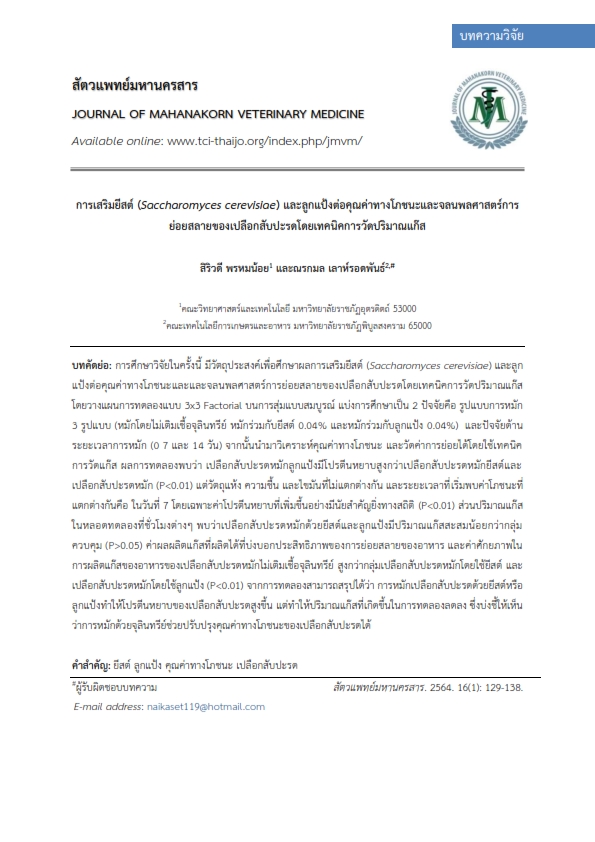Supplementation of Yeast (Saccharomyces cerevisiae) and Traditional fermentation Starter (Loog-Pang) on Nutritive Value and Kinetic of degradation of of Pineapple Peel by In vitro Gas Production Technique
Main Article Content
Abstract
This research study investigated supplementation of Yeast (saccharomyces cerevisiae) and traditional fermentation starter (Loog-Pang) on nutritive value of and kinetic of degradation of of pineapple peel by in vitro gas production technicque. A 3x3 factorial experiment was conducted in a 3x3 factorial completely randomized design (CRD), which divided into 2 factors: 3 fermentation processes (non-microbial fermentation, fermentation with 0.04% saccharomyces cerevisiae and fermentation with 0.04% traditional fermentation starter), and fermentation time (0, 7 and 14 days). Proximate analysis was performed to determine the nutritive value, and digestibility was measured using the gas production technique. The results showed that pineapple peels fermented with traditional fermentation starter had higher crude protein than those with the other fermentation processes (P<0.01), but showed no difference in dry matter, moisture and lipid. It was found that the nutritive value started to change on the 7th day, particularly crude protein content which was significantly increased (P<0.01). The gas accumulation at different hours showed that pineapple peels fermented with yeast and traditional fermentation starter had less accumulated gas than the control group (P>0.05). The gas production from the degradable fraction (b), and the potential extent of gas production (a+b) of the pineapple peels (control group) was higher than the pineapple peels fermented with yeast and with traditional fermentation starter (P<0.01). It can be concluded that fermentation with yeast and traditional fermentation starter increased crude protein in the pineapple peels, but decreased the gas accumulation in the experiment, indicating that microbial fermentation processes potentially enhance the nutritive value of pineapple peels.
Article Details

This work is licensed under a Creative Commons Attribution-NonCommercial-NoDerivatives 4.0 International License.
References
Apichartsrungkoon, T. and T. Vearasip. 1989. Duoenal and ileum cannulation in cattle. Journal of Agriculture. 5(1): 29-36. (in Thai).
AOAC. 2000. Official Method of Analysis of AOAC International. 17th ed. The Association of Official Analytical Chemists, Virginia.
Forsberg, C. W., E. Forano, and A. Chesson. 2000. Microbial adherence to the plant cell wall and enzymatic hydrolysis. P.79-97. In: P. B. Cronje. Ruminant physiology: Digestion, Metabolism, Growth and Reproduction. CABI Publishing, UK.
Hantai P., C. Chueaphudi, W. Tartrakoon, T. Incharoen, B. Plangsungnern, S. Yammuen-art, T. Kassanuk and N. Laorodphan. 2019. Supplementation of Cassava Chip and Traditional Fermentation Starter (Loog-Pang) in Sugar Cane Silage on Chemical Composition and in vitro digestibility. Khon Kean Agr. J. 47 (Suppl. 1): 825-832. (in Thai).
Jamsawat, V., S. Sareepatcharaporn and J. Chinsuwan. 2015. Research on efficiency of using pineapple waste as roughage, cassava by-product as based energy and local legume as protein supplement for feeding beef cattle. Rajamangala University of Technology Tawan-ok Research Journal. 8(1) January-June 2015: 91-99. (in Thai).
Kaewhom, P. 2020. Nutritive value and methods of improving sugarcane bagasse quality for apply in animal feeds. J. Mahanakorn Vet. Med. 2020. 15(2): 131-140.
Kaewprachum, C. 2020. Effects of recipe development on turkey production performance. Journal of Vocational Institute of Agriculture. 2(1) January-June 2020: 58-65. (in Thai).
Menke, K. H., and H. Steingass. 1988. Estimation of the energetic feed value obtained from chemical analysis and in vitro gas production using rumen fluid.
Anim. Res. Dev., 28, 7–55.
Nopparatmaitree, M., P. Seanphoom, W. Kitpipit and K. Lertchunhakiat. 2013. The study on single cell protein production from pineapple peel by Saccharomyces cerevisiae and Bacillus subtilis for development as animal feedstuff. Khon Kean Agr. J. 41 (Suppl. 1): 80-86. (in Thai).
Phakachoed, N., T. Boonmatan, T. Pongjongmit and T. Norrapoke. 2019. Effects of yeast (Saccharomyces cerevisiae) and lookpang-khaomak on nutritive value of fermented cassava peel. Khon Kean Agr. J. 47 (Suppl. 2): 819-824. (in Thai).
Phonmun, T., T. Subanrat and S. Chumpawadee. 2015. Evaluation of metabolizable energy and digestibility of agro-industrial residues as ruminant feed. Khon Kean Agr. J. 43 (Suppl. 1): 491-499. (in Thai).
Phromnoi, S., C. Mingchai, S. Manoi, N. Kongloes and P. Aphaikawee. 2021. Effect of yeast (Saccharomyces cerevisae) fermentation for nutritive value improvement by-products and waste for feeding beef cattle. Academic Journal Uttraradit Rajabhat University Science and Technology (For local development). 16 (1) January-June 2021: 39-50. (in Thai)
Puramongkon, T. and K.Thummasaeng. 2016. Nutritive Value and Kinetic of Degradation of Cassava Ethanol Waste by in vitro Gas Production Technique. Prawarun Agricultural Journal. 13 (2) July – December 2016: 173-195. (in Thai).
Steel, R. G. D., and J. H., Torrie. 1980. Principles and Procedures of Statistics. Second Edition. New York: McGraw-Hill.
The working committee of Thai feeding stardard for ruminant. 2008. Nutrient Requirement of Beef Cattle in Thailand. Klungnana Vitthaya Press. Khon Kean. 193 p.
Van Soest, P. J., J. B. Robertson and B.A. Lewism. 1991. Methods for Dietary Fiber Neutral Detergent Fiber and Non-Starch Polysaccharides in Relation to Animal Nutrition. J. Dairy. Sci. 74: 3.


